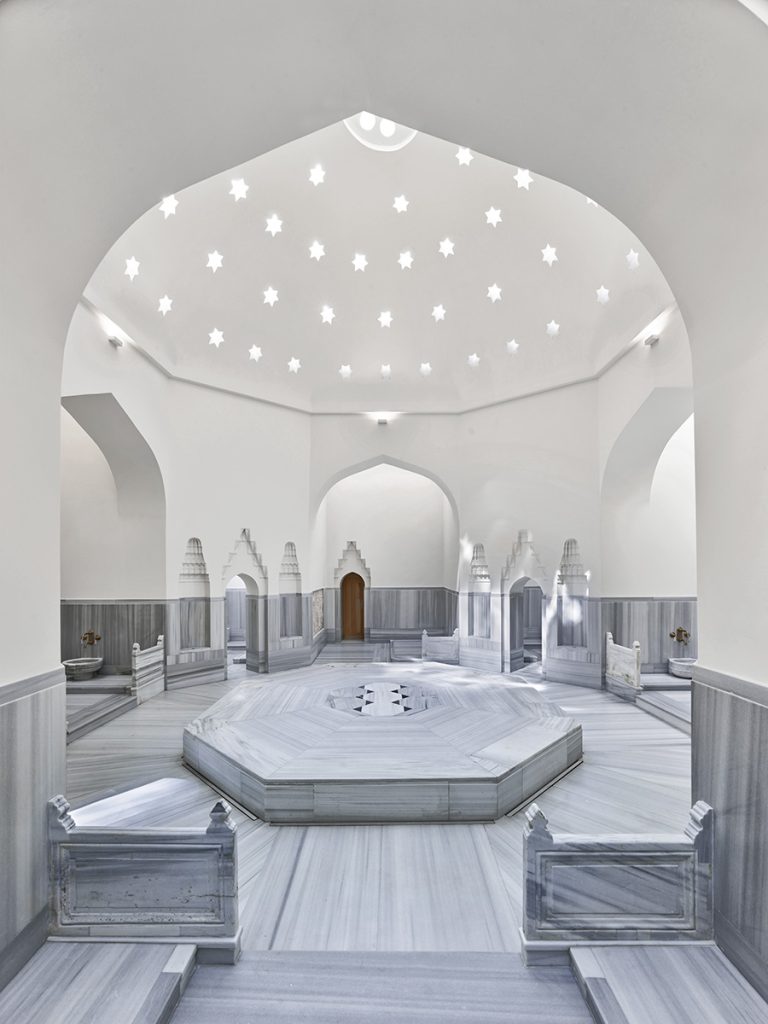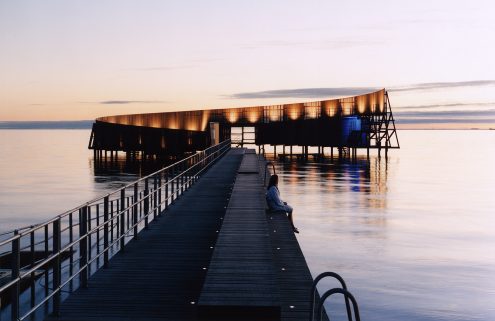Turkish baths—or hammams—are among the country’s most famous landmarks and an essential staple of its cultural fabric, given their centuries-old tradition. Rooted deeply in the history of the Ottoman Empire and the Middle East, they still play a critical role in social and religious life, serving as public bathhouses and social spaces.
Hammams are also architecturally elaborate structures that reflect their multi-layered societal role with a seemingly endless sequence of rooms, each designed with a specific ritual in mind.
One of Istanbul’s oldest hammams, Zeyrek Çinili (meaning ’tiled’ in Turkish) in the city’s UNESCO World Heritage Site district of Zeyrek, has re-emerged from a multi-million 13-year-long renovation. The historic building was built between 1530 and 1540 by architect Mimar Sinan at the commission of Hayreddin Barbarossa, admiral of the Ottoman Empire. Almost 500 years later, the historical complex is now owned by real estate and hospitality conglomerate The Marmara Group, who enlisted local firm KA-BA Architects to lead its epic revival.

Women’s Cold Room. Photography: İbrahim Özbunar.

Men’s Hot Room. Photography: İbrahim Özbunar.

Men’s Hot Room. Photography: İbrahim Özbunar.

Women’s Hot Rom. Photography: İbrahim Özbunar.

Men’s Hot Room ceiling, Zeyrek Çinili Hamam. Photography: İbrahim Özbunar.

Zeyrek Çinili Hamam, interior shot. Photography: İbrahim Özbunar

Zeyrek Çinili Hamam, interior shot. Photography: Murat Germen.

Zeyrek Çinili Hamam, interior shot. Photography: Murat Germen.

Women’s Cold Room. Photography: İbrahim Özbunar.

Women’s Cold Room. Photography: İbrahim Özbunar.

Zeyrek Çinili Hamam, interior shot. Photography: Orhan Cem Çetin.

Men’s Cold Room. Photography: İbrahim Özbunar.

Men’s Cold Room. Photography: İbrahim Özbunar.

Zeyrek Çinili Hamam, exterior. Photography: İbrahim Özbunar.

Zeyrek Çinili Hamam, exterior. Photography: Murat Germen.

Zeyrek Çinili Hamam x Hussein Chalayan. Photography: Turan Ertekin.

Bathing objects, Zeyrek Çinili Hamam Museum. Photography: Özkan Önal.

Clogs, Zeyrek Çinili Hamam Museum. Photography: Özkan Önal.

Zeyrek Çinili Hamam Museum. Photography: Giovanni Emilio Galanello.
Contemporary design blends with the building’s ancient Ottoman features, which have been sensitively restored and showcased, including fragments of Iznik tiles, wall paintings, and hidden Byzantine cisterns.
This mix of old and new is crucial to the hammam’s experience. One of its signature rituals revolves around a central stone, known as asgöbektaşı, where guests can relax under a scenic starry dome before experiencing treatments within site-specific marble massage units designed by Athens-based artist Theodore Psychoyos.
The bathhouse concept has been further enhanced for the 21st century by activating it as a multifunctional hub, adding a museum celebrating Turkey’s bathing culture and the building’s intricate history, and an event space.

KA-BA’s founding principal Cengiz Kabaoğlu discusses the renovation process and challenges of working with such a historic structure.
What were the most significant challenges you faced restoring such an ancient and layered structure?
This is a kind of ‘Sword of Damocles’ that constantly hangs over conservation and development projects. When I first saw it, it was in such a deplorable condition that it looked very dilapidated, with all the wrong interventions and incompatible additions belonging to the past. The structural fabric of the building’s domes and vaults was disintegrated, and some were about to collapse. The walls were covered with cement plaster, and their surfaces were swollen and mossy. Calcification formations were visible on the valuable tiles.
The details of each muqarnas had eroded, melted away. Some marble basins were cracked and some marble coverings were broken.
The juxtaposition of the ‘old’ and the ‘new’ is a serious issue. This leads us to evaluate how technical and aesthetic elements are handled and finalised together in a cultural heritage project. I believe that architectural mastery or success emerges in ‘shades of grey’. The compatibility of the ‘old’ and the ‘new’ is the problematic that affects me in such projects and, therefore, the one I focus on the most.

Tell us about your approach to re-designing the space for its new ‘multifunctional’ role as a museum and event venue.
I should mention that at the beginning of the project, the site was relatively small in terms of accommodating the above functions. In addition, there were fragmented open spaces and other buildings around the Zeyrek Çinili Hamam. However, it was pretty comforting for us that the first and main use Bike Gürsel (board member of The Marmara Group) identified for the hammam was a bathhouse and that the original architectural scheme of the building, consisting of the main sections of ‘frigidarium’, ‘tepidarium’, ‘caldarium’.
The preservation of this classical scheme is important not only for the principles of conservation science and art but also for the survival of Ottoman baths and their ‘traditional bathing—purification—resting—entertainment culture’.
In Turkish culture, the ritual of bathing is valued for the healthy mental relaxation it brings. The other side of this ritual is to have fun along with relaxation. This tradition has given birth to certain social habits and customs such as ‘bridal baths’, ‘puerperal baths’, ‘circumcision baths’, ‘soldier baths’, ‘votive baths’ and the like. It is pleasing to see that these rituals will be kept alive at a significant level of quality in the Zeyrek Çinili Hamam.
Including the larger parcel on the Southwest side of the hammam has created the opportunity to dedicate an area for cultural and artistic events.
However, the most important opportunity for us came when we received the necessary permission from the Preservation Board to build the Zeyrek Çinili Hamam’s annex in the area where the remains of the ‘külhan’ (the ‘praefurnium’ in the Roman baths) on the Southeast side of the bath.
In this way, we got the chance to exhibit the mother-of-pearl inlaid clogs, embroidered loincloths, and silver bowls in Bike Gürsel’s private collection, as well as the tile fragments we found during archaeological excavations in the Project Site and, to a more limited extent, inside the hammam.
During the archaeological survey and structural foundation excavations, cisterns dating back to earlier times were uncovered at lower levels on the Northeast and Northwest sides of the Project Site, which was very exciting in itself. We found out that during the construction of the hammam, Sinan took advantage of the strong walls of these old buildings and fully integrated the water system with the city’s ancient water system.

What are your favourite features of the building?
I immediately think of the ‘Ilıklık’, which bears the original traces of tile mortars dating back to the 16th century; the multi-layered ornamentations on the walls of the ‘Sogukluk’ dating back to the 18th and 19th centuries, and the corner chambers of the ‘Sıcaklık’ having the magnificent mastery that created the white muqarnases, which were meticulously repaired and renewed.
Spatial perception is a very crucial issue. Although architectural elements shape a space or feature within a building or area, a project site can only be properly understood by visiting successive spaces, that is, by passing through them in sequence. This leads us to focus on the whole rather than individual elements within many.
During the creation of the ‘Zeyrek Çinili Hamam Museum and annexe, we carried out the important task of content development for the exhibition design. The exhibition design was achieved later by the German-based group Atelier Brückner. Our main idea was to have
displays across the hammam rather than just the museum, also possessing plans to extend the exhibition to the open spaces.

The Hammam is located in the UNESCO World Heritage Site area of Zeyrek. How has its peculiar atmosphere shaped the restoration process?
The Project Site is within a historic place called ‘Kadınlar Pazarı’ (‘Women’s Market’).
Large plane trees cover the crowded and busy environment. Through our research, we have learned that in the Ottoman Period, this marketplace was always bustling and busy. The people of this district then were rich and notable people living in large wooden mansions in the vicinity.
Today the people around, most of them are shopkeepers, restaurant owners, waiters, and locals from the eastern regions of the country. From the very beginning, they were all interested in the project and followed the progress of the construction.
The significance of the area rather comes from its past. In this part of the city, there are many historic structures and ancient remains. The well-known Monastery of the Pantocrator from the Middle Byzantine Period and the Aqueduct of Valens, originally built in the times of the Eastern Roman Empire, are some of them.
Zeyrek Mah. İtfaiye Cad. No: 44 34083 Fatih, Istanbul.
























